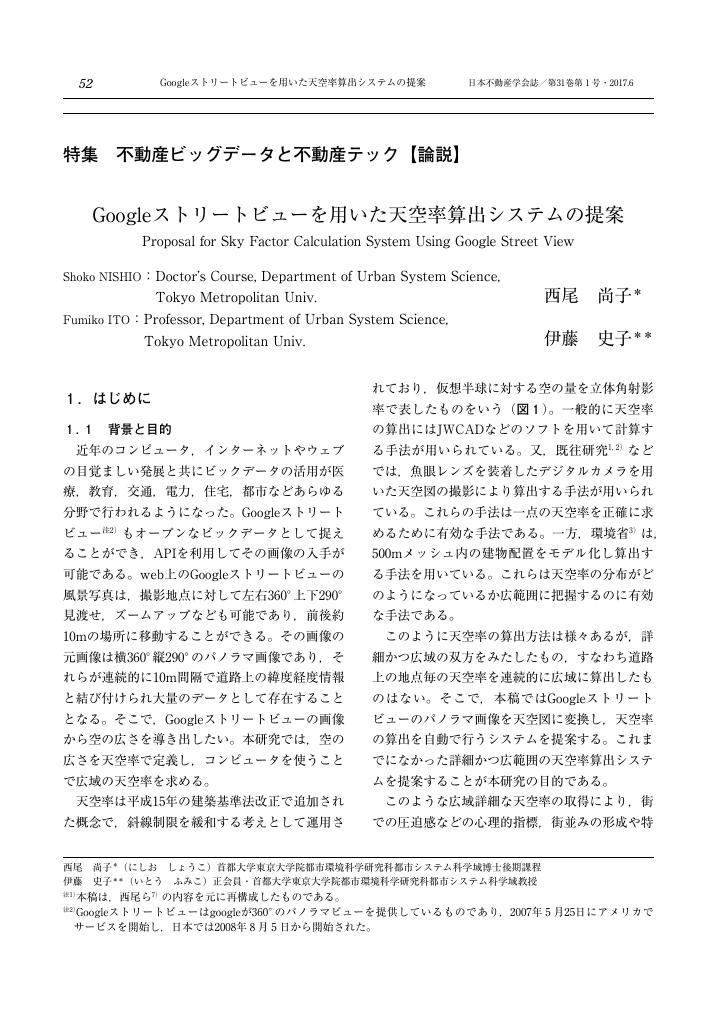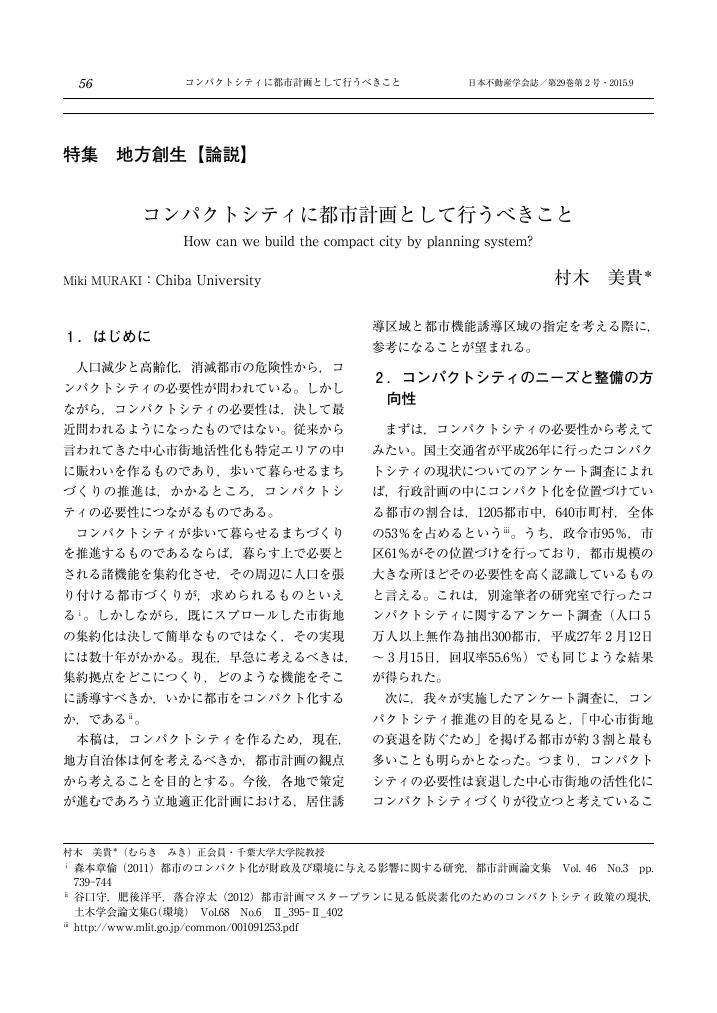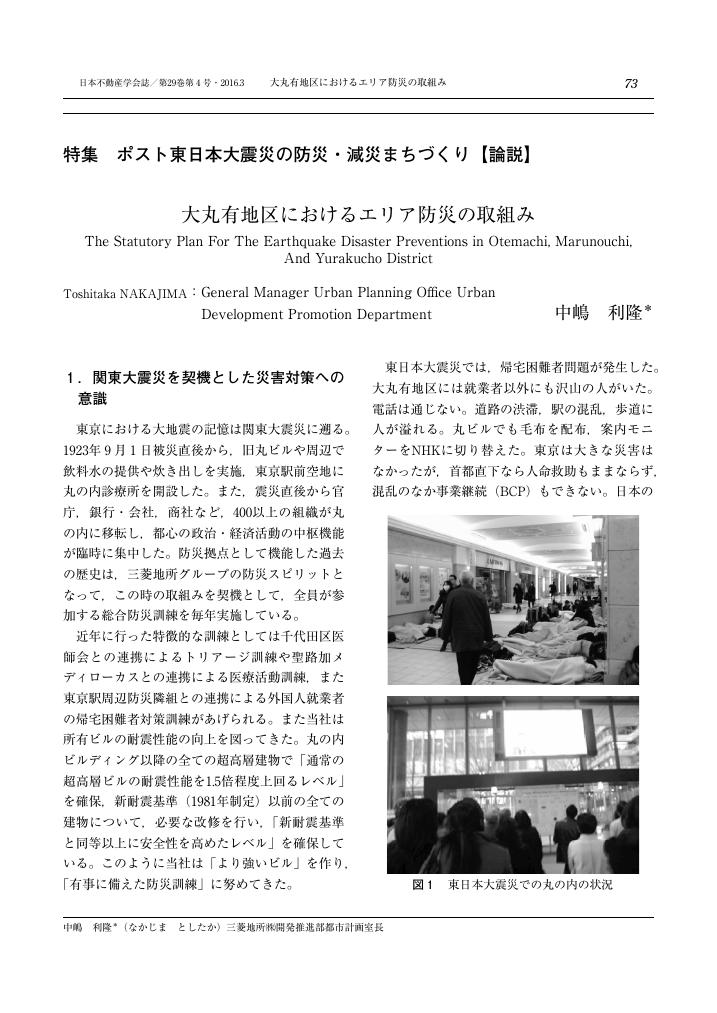1 0 0 0 OA 東日本大震災によるマンション居住・管理への影響と課題
- 著者
- 齊藤 広子
- 出版者
- 公益社団法人 日本不動産学会
- 雑誌
- 日本不動産学会誌 (ISSN:09113576)
- 巻号頁・発行日
- vol.25, no.2, pp.126-135, 2011-10-25 (Released:2016-10-17)
- 参考文献数
- 2
- 著者
- 山本 薫子
- 出版者
- 公益社団法人 日本不動産学会
- 雑誌
- 日本不動産学会誌 (ISSN:09113576)
- 巻号頁・発行日
- vol.30, no.2, pp.61-65, 2016
- 著者
- 樋野 公宏
- 出版者
- 公益社団法人 日本不動産学会
- 雑誌
- 日本不動産学会誌 (ISSN:09113576)
- 巻号頁・発行日
- vol.33, no.3, pp.69-72, 2019-12-26 (Released:2020-12-26)
- 参考文献数
- 7
Pokémon GO attracted attention from the perspective of health, especially with its potential to increase physical activity. The present study confirmed a difference in step counts between middle-aged and elderly players and nonplayers before and after the release of Pokémon GO. According to a 2-way repeated-measures analysis of variance, step counts were higher until 7 months after the release. The player group maintained their step counts in winter, despite the decrease in step counts of nonplayers. In subgroup analyses, players were more likely to be men, aged <55 years, workers, active, and subjectively in good health.
1 0 0 0 OA 賑わい創出のための広場空間の設計と空間評価
- 著者
- 国土交通省 国土技術政策総合研究所 都市研究部 都市施設研究室
- 出版者
- 公益社団法人 日本不動産学会
- 雑誌
- 日本不動産学会誌 (ISSN:09113576)
- 巻号頁・発行日
- vol.33, no.2, pp.52-57, 2019-09-27 (Released:2020-09-27)
1 0 0 0 OA Googleストリートビューを用いた天空率算出システムの提案
- 著者
- 西尾 尚子 伊藤 史子
- 出版者
- 公益社団法人 日本不動産学会
- 雑誌
- 日本不動産学会誌 (ISSN:09113576)
- 巻号頁・発行日
- vol.31, no.1, pp.52-57, 2017-06-29 (Released:2018-06-29)
- 参考文献数
- 7
1 0 0 0 OA コンパクトシティに都市計画として行うべきこと
- 著者
- 村木 美貴
- 出版者
- 公益社団法人 日本不動産学会
- 雑誌
- 日本不動産学会誌 (ISSN:09113576)
- 巻号頁・発行日
- vol.29, no.2, pp.56-60, 2015-09-30 (Released:2017-01-27)
- 参考文献数
- 8
1 0 0 0 〔追悼〕熊田禎宣先生を悼む
1 0 0 0 OA 〔追悼〕熊田禎宣先生を悼む
1 0 0 0 OA 都市の回遊性の概念化に関する考察
- 著者
- 川津 昌作
- 出版者
- 公益社団法人 日本不動産学会
- 雑誌
- 日本不動産学会誌 (ISSN:09113576)
- 巻号頁・発行日
- vol.29, no.1, pp.95-104, 2015-06-25 (Released:2017-01-26)
- 参考文献数
- 23
- 被引用文献数
- 3
In recent years, it is becoming increasingly necessary to revitalize rural areas, improve competitive strategies in commercial areas and promote tourism through the advancement of pedestrian flow in urban areas. In this study, we examined the conceptualization of urban pedestrian flow and in doing so revealed a conceptual structure for it. The concept of high pedestrian flow should both increase productivity through the integration from the supply side and consumption side, as well as contribute to town equity.
1 0 0 0 OA 大丸有地区におけるエリア防災の取組み
- 著者
- 中嶋 利隆
- 出版者
- 公益社団法人 日本不動産学会
- 雑誌
- 日本不動産学会誌 (ISSN:09113576)
- 巻号頁・発行日
- vol.29, no.4, pp.73-77, 2016-03-28 (Released:2017-03-28)
- 被引用文献数
- 1
1 0 0 0 OA 地方創生政策を評価する:経済学の視点
- 著者
- 山崎 福寿 中川 雅之 瀬下 博之
- 出版者
- 公益社団法人 日本不動産学会
- 雑誌
- 日本不動産学会誌 (ISSN:09113576)
- 巻号頁・発行日
- vol.29, no.2, pp.42-48, 2015-09-30 (Released:2017-01-27)
- 参考文献数
- 10
- 被引用文献数
- 1
1 0 0 0 OA 公共施設更新問題に対する秦野市の取組み
- 著者
- 志村 高史
- 出版者
- 公益社団法人 日本不動産学会
- 雑誌
- 日本不動産学会誌 (ISSN:09113576)
- 巻号頁・発行日
- vol.25, no.4, pp.57-65, 2012-03-16 (Released:2016-10-19)
1 0 0 0 OA 2015年度日本不動産学会学会賞選考結果の報告
- 著者
- 浅見 泰司
- 出版者
- 公益社団法人 日本不動産学会
- 雑誌
- 日本不動産学会誌 (ISSN:09113576)
- 巻号頁・発行日
- vol.30, no.3, pp.86-91, 2016-12-26 (Released:2017-12-26)
1 0 0 0 OA スペース・シンタックス指標を用いた賃料要因分析に関する研究
- 著者
- 太田 明 高橋 大志 兼田 敏之
- 出版者
- 公益社団法人 日本不動産学会
- 雑誌
- 日本不動産学会誌 (ISSN:09113576)
- 巻号頁・発行日
- vol.31, no.4, pp.109-118, 2018-03-26 (Released:2019-03-26)
- 参考文献数
- 15
- 被引用文献数
- 2
As a case study of around the Shibuya station, the multiple regression analysis of housing, office and commercial rent was examined with building and location measures including visibility and integration value by space syntax theory as candidate factor variables. After the factor variables were adopted by t-test, we compared and considered the multiple regression models of housing, office and commercial use, using the factor ranking by t-value. The result showed integration value of space syntax measures were adopted in all models, although the ranking was different in each models.
1 0 0 0 OA 不動産バブルの教訓
- 著者
- 清水 千弘
- 出版者
- 公益社団法人 日本不動産学会
- 雑誌
- 日本不動産学会誌 (ISSN:09113576)
- 巻号頁・発行日
- vol.25, no.1, pp.29-38, 2011-07-20 (Released:2015-10-19)
- 参考文献数
- 12
- 被引用文献数
- 1
The advent and collapse of real estate bubbles, or the sharp rises and falls in real estate prices, have posed major economic issues in many contries. Real estate prices soared sharply in Japan and Sweden in the 1990s and recently in many Western countries (until the mid─2000s), until plunging in the wake of the financial crisis in the United States. The rapid rise and fall of real estate prices in Japan from the mid-1980s to the 1990s is said to represent the most significant real estate bubble of the 20th century. Following the collapse of this bubble, Japan experienced a long period of economic stagnation, often cynically described as the“l ost decades.” What have we learned from these ups and downs in the real estate market? Have recent real estate investment risk management efforts incorporated these lessons? To answer these questions, this paper would like to pay attention to the severalty of each real asset. The lesson learned from last century's economic bubble and from the expansion and shrinkage of the real estate market in the wake of the latest financial crisis is that real estate investment risks cannot be dispersed by diversifying investments, and major risks will remain unless assets are carefully selected.
1 0 0 0 OA 【2013年度秋季全国大会(学術講演会)ワークショップ】 地下水の保全と利用
- 著者
- 守田 優 本間 勝 奥田 進一
- 出版者
- 公益社団法人 日本不動産学会
- 雑誌
- 日本不動産学会誌 (ISSN:09113576)
- 巻号頁・発行日
- vol.27, no.4, pp.115-120, 2014-03-17 (Released:2017-01-20)
- 著者
- 北居 功
- 出版者
- 日本不動産学会
- 雑誌
- 日本不動産学会誌 (ISSN:09113576)
- 巻号頁・発行日
- vol.30, no.1, pp.22-26, 2016
1 0 0 0 所有者不明土地の実態と課題
- 著者
- 吉原 祥子
- 出版者
- 公益社団法人 日本不動産学会
- 雑誌
- 日本不動産学会誌 (ISSN:09113576)
- 巻号頁・発行日
- vol.31, no.3, pp.79-83, 2017
- 被引用文献数
- 1
Abandoned and unclaimed land has emerged as a major policy issue in Japan, where the population is dwindling and property values are falling everywhere but in the big cities. This article analyzes this alarming issue using the results of a nationwide survey conducted by the author targeting 1,719 local authorities, which revealed a disconnect between the existing land ownership system and rapid demographic change. Policy initiatives are needed to address three basic challenges, namely, how to get people to register title transfers when they inherit real estate; how to protect and manage land that has no immediate prospect for use; and how to improve the data collection and management infrastructure.









